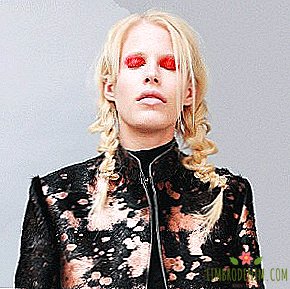And she crushed his hips: 7 myths in feminist optics
Feminism is probably the last thing that comes to mind when talking about myths. Most often, the latter are associated with the "male" world and the "male" culture: while male heroes fight the unjust world, women intrigue them - like, for example, Herak, who hated Hercules. But, fortunately, this is not always the case, sometimes in myths there are quite feminist heroines and plots. Although, of course, with the amendment to the era - remember how often in the myths of various nations there are violence, incest and bestiality. In addition, today, myths are increasingly trying to reconsider from modern positions - they can be seen, say, unwillingness to fit into the binary gender system, the homosexuality of heroes and much more. We decided to recall a few feminist myths from different countries that deserve attention today.

alexander savina
Gorgon Medusa

Medusa is probably one of the most recognizable images of Greek mythology. In the most famous version, Medusa is one of three Gorgon sisters who have frightening looks (fangs, snakes instead of hair), which turns the beholder into stone. According to the myth, a woman dies from the hand of Perseus: he manages to decapitate her, looking at the reflection in the shield.
In the later version of the myth set forth by Ovid in “Metamorphoses”, Medusa appears as an ordinary girl - and her story sounds much more modern than you can imagine. God Neptune, seeing Medusa, decides to seize it - and rapes in the temple of Minerva. The goddess "of wisdom and war", angered by the fact that her temple was desecrated, brings punishment - but not to the rapist, but to his victim. She turns Medusa into a monster with snakes instead of hair, and then hands Perseus the same shield.
It was Medusa who became one of the first heroines that they decided to look through through feminist optics: researchers began to think about how women were represented in the history of culture and why the masculine look still dominates in the interpretations of ancient texts. Today in the history of Medusa they offer to see not only and not so much the monster that turns men into stone, but the victim of violence affected by the way others were treated - including those with authority.

Hine-nui-te-po
The story of Hine-nui-te-po, the goddess of night and death in Maori mythology, is also tragic. At birth, she received the name Hinetitama; she was married to her own father, Tanya, the god of forests and birds. Tanya hoped with the help of Khinetitama to continue the race, and she gave birth to a daughter, unaware of blood ties. Once a woman thought about her origin: when Tanya left the answer, asking her to ask about the tree from which the house was built, Hinetatama realized that Tanya was her father - and ran away from him into the realm of the dead in horror. So she became Hine-nui-te-po, the goddess who watches over the dead.
Perhaps the most famous myth about Hin-nui-te-po concerns the demigod Maui - one of the most prominent heroes of Maori mythology (you could see him, for example, in the cartoon "Moana"). The hero wanted to give humanity immortality and for this purpose was going to outwit Khine-nui-te-po, as if turning the process of childbirth reversed: climb into the sleeping goddess and then climb out of her mouth (we leave aside the anatomy of the idea) . Maui took the forest birds with him, but demanded that they in no way laughed and did not accidentally wake the deity. But when Maui began to climb into the vagina, one of the birds still could not stand it and giggled - Hine-nui-te-po woke up, squeezed the hips and crushed the hero. According to some versions, the vulva of the goddess had obsidian teeth - practically the vagina dentata.
Mayari

Mayari - the goddess of the moon in Filipino mythology, the daughter of the children of Batal, the creator god, and the mortal woman. One of the Filipino stories tells the story of the battle of Mayar and Apolaki, a deity who commands the sun. When once Batal fell ill, Mayar and Apolaki argued over who would rule the world: Apolaki believed that he had a right to do so, like a man, and Mayar believed that, like a daughter of Batal, she should not yield to him.
Both could not agree and decided to fight - and fought until Apolaki expelled Mayari eyes. Seeing what he did, Apolaki was immediately horrified. As a result, the deities decided to rule the Earth alternately - day and night, respectively. And although the woman became a victim of violence in the typical way for the ancient myths, the gods quite modernly divided their duties in half, assuming that a peaceful solution of issues is more effective than aggression.

Morrigan
Morrigan is the Irish goddess of war and death. It is believed that it exists simultaneously in three guises, like the Christian god, although you can find another, more rare version, where three goddesses are sisters, and not one being. The incarnations that make up Morrigan differ from source to source, although they most often speak of Badb, Nemain and Mach.
One of the most famous stories about Mach is found in medieval Irish literature. In this version, the goddess became the wife of Krunhu, a simple inhabitant of Ulad (the medieval name of the province of Ulster), but strictly forbade him to tell about her. Nevertheless, once Krunhu boasted to the king that his wife was able to outrun the royal horses, which is why he decided to arrange a competition between a woman and horses.
Maha was pregnant, but still took part in the competition - and managed to overtake the horses. At the end of the race, crying out in pain, she sent a curse on the inhabitants of Ulada: when they needed power especially, they would suffer for a few days, like pain during childbirth - and this curse should last for nine generations. And although this story is a little like a happy one, she pays tribute to "invisible" female labor - and the difficulties of childbearing.
Sedna

Sedna is the heroine of Inuit mythology, the indigenous people of North America, the goddess of the sea and sea creatures. There are several versions of the legend of Sedna, but more often they are built around the fact that the girl did not want to get married (according to one of the versions, Sedna chooses her dog husband). She refused to suit the groom for a long time, until one of them still struck her, promising a wonderful life. However, in fact, the promises turned out to be empty: the husband turned into a bird, and instead of a warm, cozy home, a cold and hard bed awaited the woman.
After a while, Sedna’s father decided to visit his daughter and, horrified at how her husband was treating her, killed the deceiver and took the girl with him. Birds, enraged by the death of Comrade, pursued the sea storm with their wings and chased after Sedna and her father. Fearing that the boat would turn over, Sedna’s father decided to throw his daughter overboard, but she clutched at the dead grip. Then her father cut off her fingers - out of which sea creatures emerged: whales, seals and others. When the birds considered the girl dead, he helped her to get back into the boat. Sedna, however, did not forgive her father and took revenge on him, ordering the dogs to gnaw hands and legs of a man.
In Inuit mythology, the story of Sedna seems to be connected with the change of seasons, but by interpreting it literally, one can discern a modern idea: for happiness it is not necessary to get married, and marriage itself is not a guarantee of a successful life. Although, of course, cutting off the fingers and bloody revenge can hardly be called progressive.

Mami vata
Mami Vata translates as "mother water" - this name refers to the whole pantheon of aquatic deities worshiped in different countries of Africa. Among the spirits there can be men, but, nevertheless, most often Mami Vata is depicted as a female being resembling a mermaid - half a woman, half a fish or a snake. Mami Vata is largely associated with "well-being", with which she awards loyal followers who abide by her laws. It is not only and not so much about wealth as such, but also about the simple opportunity to provide for yourself and your family - as well as spiritual wealth.
Mami Vata is known for her beauty - while she is a dangerous and powerful creature. It is believed that Mami Vata kidnaps lost swimmers and converts them to their faith. Perhaps this is why she is often associated with sexual freedom and emancipation, which is not so obvious to the goddess: sex for its own pleasure with many different partners is associated primarily with male gods. True, many modern admirers of Mami Vata believe that to reduce her to a “liberated temptress” means to simplify the image and role of the spirit.
In addition, Mami Vata is known as a protector of mothers and children, as well as women who have been victims of violence - this challenge is still important today.
Metis

Another heroine of Greek mythology is Oceanis (that is, the daughter of the Ocean) Metis, who was an educator and the first wife of Zeus. She helped him to release from the womb of the titan Kronos the children-gods he had swallowed, which later formed the familiar pantheon.
From Gaia and Uranus, Zeus heard a prophecy that a child born of Metis would overthrow him, just as he overthrew Kronos. In fear of losing power, Zeus swallowed pregnant Metis (running away from him, she turned into a fly, and he into a lizard) - after which the goddess of wisdom Athena was born from his head.
In the more modern interpretations of the myth, there is another version of events: it was not Zeus who fooled Metis, but she herself had deceived him by urging her to swallow her. She deliberately sacrificed her own freedom to remain forever inside Zeus and thus influence the decisions of God and restrain his violent temper. Given the problematic behavior of Zeus, it sounds really noble.





